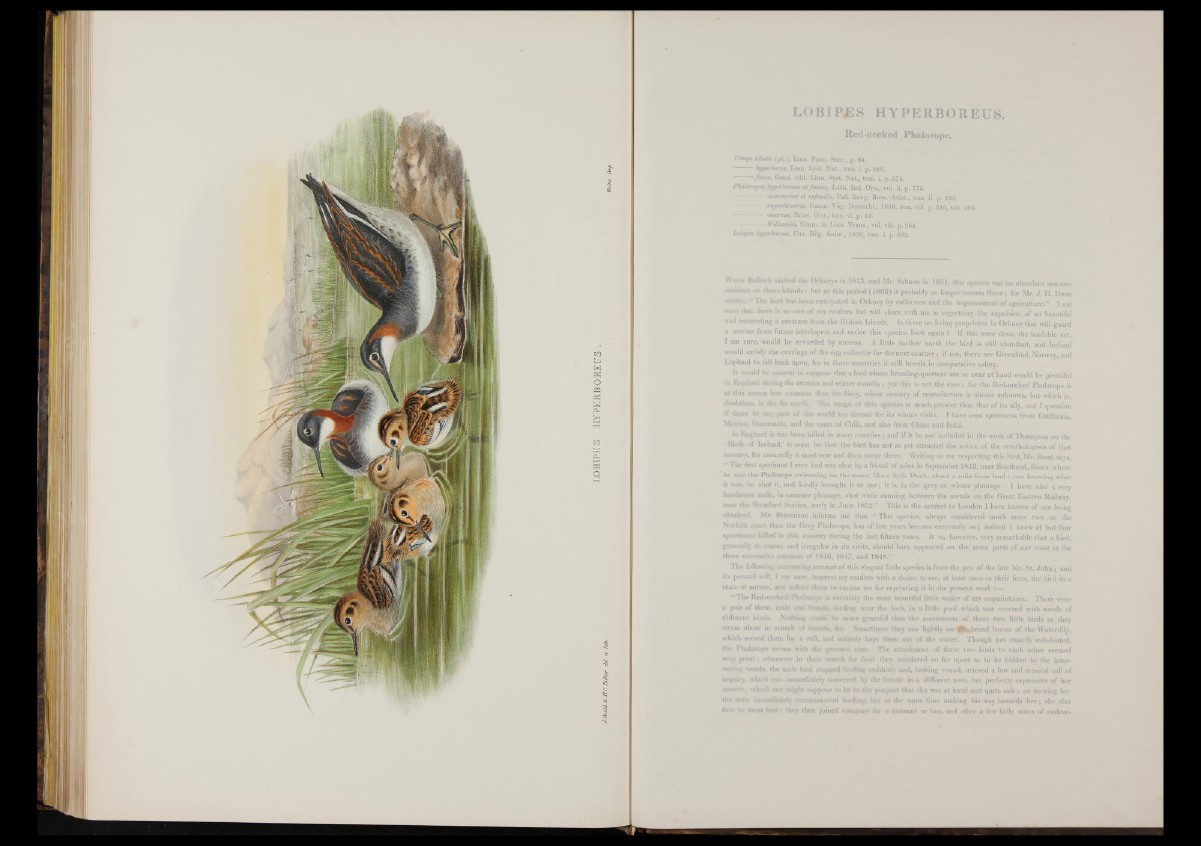
LOBIPES HYPERBOREUS.
Red-necked Phalarope.
Tringo lobais (pt.), Linn. Faun. Suec., p. 64.
hfperborea, Linn. Syst. Nat., tom. i. p. 249.
■------- fusca, GmeL edit. Linn. Syst. Nat., tom. i. p. 675.
Phalaropia hyperboreus et fuscus, Lath. Ind. Om., vol. ii. p. 775.
— einerascens et ruficollis, Pall. Zoog. Ross.-Asiat., tom. ii. p. 203.
— angustirostris, Naum. Vog. Deutschl., 1836, tom. viii. p. 240, tab. 205.
— cinereus, Briss. Om., tom. vi. p. 15.
Wittiam'di, Simm. in Linn. Trans., vol. viii. p. 264.
Lobipe* hgperboreus, Cuv. Reg. Anim., 1829, tom. i. p. 532.
When Bullock visited the Orkneys in 1813, and Mr. Salmon in 1831, this species was an abundant summer
resident on those islands: but a t this period (1866) it probably no longer resorts th e re ; for Mr. J . H. Dunn
write*, “ th e bird has been extirpated in Orkney by collectors and the improvement o f agriculture.” I am
sure that there is no one of my readers but will share with me in regretting the expulsion o f so beautiful
and interesting a creature from the British Islands. Is there no living proprietor in Orkney that will guard
a morass from future interlopers and entice this species back again ? If this were done, the laudable act,
I am sure, would be rewarded by success. A little further north the bird is still abundant, and Iceland
would satisfy the cravings o f the egg-collector for the next century | if not, there are Greenland, Norwav, and
Lapland to fall back upon, for in those countries it still breeds in comparative safety.
It would be natural to suppose that a bird whose breeding-quarters are so near a t hand would be plentiful
in England during tlie autumn and winter m onths; yet this is not the c a se ; for the Red-necked Phalarope is
at this season less common than the Grey, whose country o f reproduction is almost unknown, but which is,
doubtless, in the far north- The range of this species is much .greater than that of its ally, and I question
if there be any part of the world too distant for its winter visits. I have seen specimens from California,
Mexico, Guatemala, and the coast o f Chili, and also from China and India.
In England it has been killed in many counties; and if it be not included in the work o f Thompson on the
‘ Birds of Ireland,’ it must be th at the bird has not as yet attracted the notice o f the ornithologists o f that
country, for assuredly it m ust now and then occur there. Writing to me respecting this bird. M r. Bond says,
“ The first specimen I ever had was shot by a friend o f mine in September 1842, near Southend, Essex, where
lie saw the Phalarope swimming on the water, like a little Duck, about a mile from lan d : not knowing what
it was, he shot it, and kindly brought it to me ; it is in the grey or winter plumage. I have also a very
handwwHC male, in summer plumage, shot while running between the metals on the Great Eastern Railway,
near the Stratford Station, early in Ju n e 1852.” This is the nearest to Loudon I have known o f one being
obtained Mr. Stevenson informs me th at “ This species, always considered much more rare on the
Norfolk coast than the Grey. Phalarope, has o f late years become extremely s o ; indeed I know of but four
specimens killed in this country during the last fifteen years. I t is, however, very remarkable that a bird,
generally so scarce and irregular in its visits, should have appeared on the same parts o f our coast in the
three successive autumns o f 1846, 1847, and 1848.”
The following interesting account o f this elegant little species is from the pen o f the late Mr. S t. J o h n ; and
its perusal will, 1 am sure, impress my readers with a desire to see, a t least once in their lives, the bird in a
state of nature, and induce them to excuse me for reprinting it in the present work -
“ The Red-necked Phalarope is certainly the most beautiful little wader o f my acquaintance. There were
a pair o f them, male and female, feeding near the loch, in a little pool which was covered with weeds of
different kinds. Nothing could be more graceful than the movemeuts o f these two little birds as they
swam about in search of insects, &c. Sometimes they ran lightly on Ithc^broad leaves o f the Water-lily,
which served them for a raft, and entirely kept them out o f the water. Though not exactly web-footed,
the Phalarope swims with the greatest ease. The attachment o f these two birds to each other seemed
very g r e a t; whenever in their search for food they wandered so far apart as to be hidden by the intervening
weeds, the male bird stopped feeding suddenly and, looking round, uttered a low and musical call of
inquiry, which was immediately answered by the. female in a different note, but perfectly expressive o f her
answer, which one might suppose to he to the purport that she was at hand and quite safe; on hearing her
the male immediately recommenced feeding, hut a t the same time making his way towards h e r ; she also
flew to meet h im ; they then joined company for a moment or two, and after a few little notes o f endear